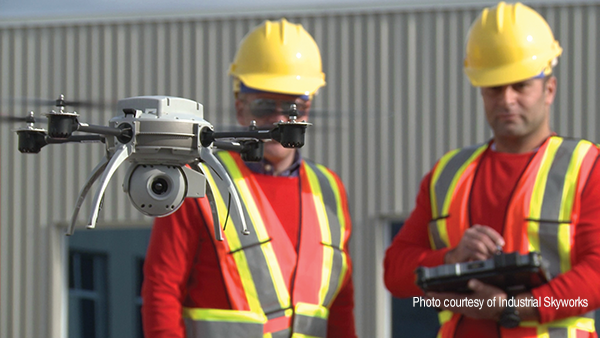
by / Jessica Kirby • photos courtesy of Industrial Skyworks
Technologies changing construction are all the rage, as the industry, known for its tried-and-true methods, is rapidly evolving to meet shorter timelines, more complex designs, and a tech-savvy workforce. Everything from iPads to artificial intelligence is affecting the way tradespeople complete their work, and this is only the beginning. One of the top named technologies in construction monitoring, inspection, and safety mitigation is unmanned arial vehicle (UAV) or drone technology and its uses are proliferating by the week.
Ian Hannah is co-founder of Industrial Skyworks and an expert in drone technology. He has developed drone inspection programs for large corporations as they deploy this groundbreaking technology, leveraging the creativity and problem-solving prowess developed during his award-winning career in film and television. His background in media exposed him early on to drone technology, and now he has become adept at successfully integrating drone technology throughout industry.
Though most of Industrial Skyworks’ jobs are in conventional wall and ceiling insulation applications, the company is rapidly moving in the direction of thermal inspections in large industrial operations.
The company currently conducts the latest non-destructive testing (NDT) drone inspection technologies for asset inspection and anomaly detection to the oil and gas and petrochemical industries, providing visual, thermal, and confined space solutions. The company’s proprietary BlueVu software automatically organizes and analyzes drone data to deliver insight about potential problems.
Although the company is just breaking into aspects of inspection of importance to thermal insulation contractors, it is a growing area of interest.
“Ultimately, we have drones inspection services for various industries and are moving into oil and gas inspections, tank inspections, flare inspections, and other areas of the industrial sector,” says Hannah. “We have found a big need for drones, especially in hard-to-reach spaces like tanks and some interior work.”
Steve Clayman, TIAC’s director of energy initiatives, says similar to the application drones in the oil and gas industry, he sees potential in the technology being used to inspect outdoor ducting, and the condition of insulation, taking thermographic images and accessing areas that can’t easily be otherwise accessed.
“There may be winter conditions where having someone go up would be dangerous,” he adds. “Winter conditions would also make for more dramatic temperature differences for thermographic imaging.”
Clayman notes the quality of the drone imaging, as noted on Industrial Skyworks’ website and available video footage. “The cameras are fantastic,” he says. “It was demonstrated the drone can actually be positioned a safe distance away from an area of interest and still catch the smallest details. The transmission is in real time so the position of the drone is maintained until the shots are truly representative of the issue.”
Being of the highest quality, the drones require a special operator, which would incur a cost building owners would have to assume, with a contractor’s advice.
“We have work in these areas or fields for sure,” says Hannah, “an as we continue to develop our processes, especially to interior work, our ability to do visual inspections will increase. We could definitely do some different and more specific thermal work in the future.”
Ian Hannah will speak at the TIAC Conference in Montreal this August, focusing on his work in roof and wall scanning using UAV technology and highlighting the Skybeam project Industrial Skyworks built for Tremco. He will provide examples of work carried out that show the effectiveness of thermal and visual photography by UAV with examples of wall, roof, and industrial application reports, a discussion of rules and regulations around the use of drones in the building sciences, and advice on how to use them for best results. Contact the TIAC office or see the registration forms on page 21 in this issue to register for this year’s conference August 24-27. ▪
